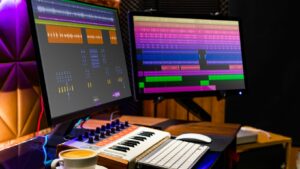 In the ever-evolving world of music, production techniques play a pivotal role in shaping the soundscape of today’s hits. As technology advances, producers harness innovative tools and methods to create tracks that captivate listeners worldwide. From the analog warmth of vintage gear to the precision of digital software, the art of music production is a dynamic blend of creativity and technical expertise. Understanding the fundamentals of music production can empower aspiring producers to craft their unique sound. Whether it’s layering instruments, manipulating audio effects, or mastering the final mix, each technique contributes to the overall sonic experience. As more artists seek to push boundaries and redefine genres, mastering these techniques becomes essential for anyone looking to make their mark in the industry. With the right knowledge and resources, producers can transform their musical vision into reality, resonating with audiences across the globe.
In the ever-evolving world of music, production techniques play a pivotal role in shaping the soundscape of today’s hits. As technology advances, producers harness innovative tools and methods to create tracks that captivate listeners worldwide. From the analog warmth of vintage gear to the precision of digital software, the art of music production is a dynamic blend of creativity and technical expertise. Understanding the fundamentals of music production can empower aspiring producers to craft their unique sound. Whether it’s layering instruments, manipulating audio effects, or mastering the final mix, each technique contributes to the overall sonic experience. As more artists seek to push boundaries and redefine genres, mastering these techniques becomes essential for anyone looking to make their mark in the industry. With the right knowledge and resources, producers can transform their musical vision into reality, resonating with audiences across the globe.
Music Production Techniques
 Music production involves a range of techniques essential for creating professional tracks. Combining creativity with technical skills allows producers to bring musical visions to life. Effective layering creates a rich sound, with multiple instrument and vocal layers enhancing texture. Audio manipulation further shapes sounds, using tools like equalization and compression to achieve clarity. Sampling uses snippets of pre-existing audio, offering new dimensions in a producer’s work. Creativity and discretion allow producers to create unique and recognizable sounds. Automation adds dynamism, controlling volume and effects to maintain listener interest throughout a track. Each process plays a vital role in the final product’s impact. Understanding these techniques is crucial for producers to innovate and connect with a broader audience.
Music production involves a range of techniques essential for creating professional tracks. Combining creativity with technical skills allows producers to bring musical visions to life. Effective layering creates a rich sound, with multiple instrument and vocal layers enhancing texture. Audio manipulation further shapes sounds, using tools like equalization and compression to achieve clarity. Sampling uses snippets of pre-existing audio, offering new dimensions in a producer’s work. Creativity and discretion allow producers to create unique and recognizable sounds. Automation adds dynamism, controlling volume and effects to maintain listener interest throughout a track. Each process plays a vital role in the final product’s impact. Understanding these techniques is crucial for producers to innovate and connect with a broader audience.
Essential Equipment for Music Production
Successful music production relies on high-quality equipment. Using the right tools helps producers create professional soundscapes and meet industry standards.
Digital Audio Workstations (DAWs)
DAWs form the cornerstone of modern music production. Software like Ableton Live, Logic Pro, and FL Studio are popular choices. They offer extensive libraries of virtual instruments and effects, enabling producers to compose, edit, and mix with precision. These platforms support various plugins, expanding creative possibilities.
Audio Interfaces and Monitors
Audio interfaces bridge digital and analog sound, crucial for capturing high-fidelity audio. Devices from brands like Focusrite and PreSonus provide reliable connections between microphones, instruments, and computers. Studio monitors, such as those by KRK and Yamaha, ensure producers hear accurate sound without coloration, essential for precise mixing and mastering.
Microphones and Instruments
Microphones capture clear vocals and instrumentals. Condenser mics, like the Audio-Technica AT2020, excel in studio environments, while dynamic mics, such as the Shure SM58, handle live performances. Musical instruments, both physical and virtual, integrate into productions. Software synthesizers complement traditional instruments, offering a wide range of sounds for diverse genres.
Fundamental Music Production Techniques
 Music production techniques form the backbone of creating professional and engaging tracks. These techniques cover the stages of recording, mixing, and mastering, each crucial for achieving a polished final product.
Music production techniques form the backbone of creating professional and engaging tracks. These techniques cover the stages of recording, mixing, and mastering, each crucial for achieving a polished final product.
Recording techniques capture the essence of sound in the most accurate manner. Using high-quality microphones and proper mic placement is essential to produce clean and clear audio tracks. Soundproofing the recording environment minimizes unwanted noises for a pristine capture. Layering methods enhance depth by recording multiple takes and blending them seamlessly.
Mixing Techniques
Mixing techniques balance and refine audio elements within a track. Equalization (EQ) adjusts frequencies to ensure clarity and separation among instruments and vocals. Compression smooths out dynamic range disparities making the mix cohesive. Panning creates spatial distribution, ensuring each element occupies its unique place in the stereo field, enhancing listener immersion.
Advanced Music Production Techniques
The journey of mastering music production techniques is both challenging and rewarding. With the right tools and knowledge, producers can craft tracks that resonate with listeners and stand out in the competitive music landscape. As they explore advanced techniques, from intricate layering to precise audio manipulation, producers unlock new creative possibilities. Embracing technology and honing their skills allows them to push the boundaries of their art form. By continuously learning and experimenting, they not only refine their unique sound but also contribute to the evolution of music itself.

